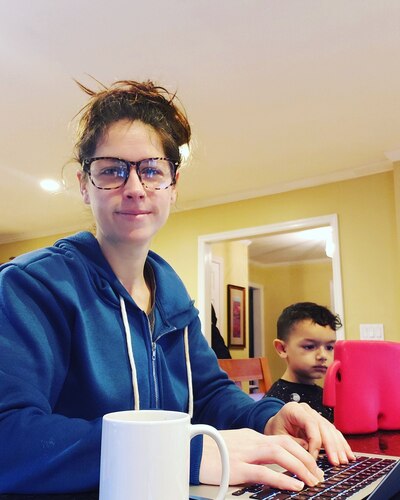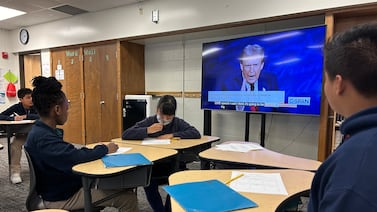Summer school officially kicked off Monday, but some of the 143,000 students enrolled in the remote program have yet to start their coursework due to technical glitches.
Summer school is being conducted entirely online due to the coronavirus pandemic, with a centralized curriculum delivered through a tool called iLearnNYC. After developing iLearn about a decade ago, the education department is now re-deploying it this summer, but teachers and principals said widespread problems with the platform have kept them from beginning to teach students.
Frank Marino, a Brooklyn teacher at M.S. 839 who signed up to teach English and social studies classes this summer, said he logged into the required online learning platform only to discover that some of the teaching materials he’s required to use were absent.
“Some teachers still don’t have access to their courses,” Marino said Tuesday, the second day of summer school for most students. “We’re still trying to get every student logged onto the platform — there are technical difficulties even with that.”
It’s a rocky start for a high-stakes summer, as schools are requiring many more students to complete additional coursework after many struggled when buildings closed in March. Additionally, the summer program’s uniform platform and curriculum — a departure from the freedom schools have during the regular school year — could foreshadow changes this fall, some observers suggest.
Bronx social studies teacher Stephanie Edmonds said she struggled to access materials for the U.S. History unit she’s supposed to be teaching on iLearn, which provides access to curriculum materials created by companies like Edmentum.

After finding a workaround, Edmonds now has access to the material — but it’s unclear if her students do. For over two hours each on Monday and Tuesday, she held virtual office hours for students who had any questions, as part of summer school’s mandate to offer more than an hour of daily live instruction. Not a single student showed up.
“It was wholly unclear on the student end,” how summer school was supposed to function, Edmonds said, noting that she did not receive clear instructions herself. “It was definitely not super clear what I was supposed to do when I showed up on Monday.”
One Brooklyn high school principal echoed some of those technical issues, saying that about half of his students who were sent to summer school did not yet have access to all of their coursework.
“When they go into iLearn they don’t see the class they’re supposed to be taking — they have no access to the teacher,” said the principal, who spoke on condition of anonymity because he was not authorized to speak publicly. The principal said some of his staff members spent hours on the phone Monday with a tech support hotline and were unable to get through.
“When the interfaces don’t work, we have no ability to do anything,” he added, including face-to-face instruction through Zoom. “It’s another self-inflicted wound by the DOE.”
Adding to the confusion, some teachers said they are still in limbo about whether they will be hired to teach summer school even though it has already begun, adding that they believe some summer school positions have still not yet been filed.
“I did the training for summer school because I thought I would be working,” said Christine Montera, a teacher at the East Bronx Academy for the Future, who signed up to teach summer school. “It doesn’t make sense to me.”
Education department officials said it was normal to continue staffing the summer school program even after it had started. They also acknowledged there have been technical snafus.
“We are working to address any technical difficulties immediately as schools and families adapt to the platforms they will be using over the next several weeks,” Miranda Barbot, an education department spokesperson, wrote in an email.
Barbot did not provide information about how the department is tracking summer school attendance or how many students had been unable to access coursework. It was not immediately clear why iLearn faced significant technical issues even though the department has used it for years. The department spent several million dollars developing iLearn, though officials did not provide an exact figure of its cost.
Some educators worried that losing a few days of summer school could make it harder to fill gaps since summer school runs only about five weeks. It’s an especially short timeframe to catch up students who have struggled the most with the transition to online learning.
On top of that, teachers are trying to quickly understand the needs of their students, many of whom they’re meeting for the first time virtually.
Marino, for instance, spent the opening days of summer school trying to get students and their families on the phone, with limited success. He said some teachers left electronic notes about why their students were being assigned to summer school while others left no information at all.
“It really does feel like it’s a widespread clash of miscommunication, last-minute thinking, and platform issues,” Marino said, adding that he is optimistic that he will be able to begin connecting with students on Zoom by Wednesday.
Despite the technical issues, some observers said there are advantages to running a centralized summer school program. Instead of requiring schools and teachers to pick from a variety of platforms such as Google Classroom and develop their own curricula, a common platform could make it easier to ensure educators have access to high-quality virtual materials and could free them up to focus more on supporting students individually. It could also make it easier for the department to track student engagement and more quickly respond to problems.
“Going with a centralized learning option is the right instinct,” said Tom Liam Lynch, who runs the website InsideSchools, and worked with the education department to implement iLearn a decade ago.
But when using a centralized platform, it’s important that teachers feel confident using it to meet students’ needs, he added.
“There was a technical glitch, fine, that will be cleared up,” Lynch said. “But once it’s cleared up, do you have teachers on the other end who have the resources and ongoing training to really provide students with personalized attention? That’s a big unknown right now.”
Some educators said they’re nervous that the education department is planning to use iLearn more widely this fall, fearing it would limit schools’ curriculum choices. Others, however, say it could give the department more flexibility to deploy staff across schools — meaning that one teacher could potentially have students from multiple schools, an option that could be helpful given that many students and staff might not attend school in person.
A second high school principal, who spoke on condition of anonymity, said the widespread technical issues with iLearn made them skeptical the platform could be deployed seamlessly this fall with significantly more students and worried that it could hamper schools that found strategies that worked for them.
“I’m worried about losing the progress we made in the spring,” the principal said, noting that schools should be given the freedom to choose the iLearn platform if they want. “I’m worried it won’t work if it’s mandatory.”
Education department officials did not say if they plan to use the platform this fall.







